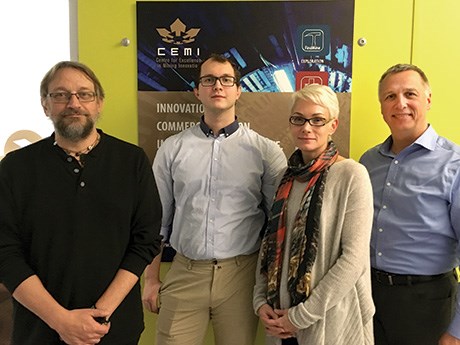Fast, safe, green technology
An innovation that accelerates mineral analysis is making mining and mineral exploration more efficient and less hazardous at a fraction of the cost of existing technologies.
“It is fast. It is safe. It is a greener technology,” said Nick Kuryluk, chief executive officer of ColdBlock Technologies Inc. The company’s laboratory equipment uses short-wave infrared radiation to dissolve ore samples in minutes without perchloric acid or other hazardous reagents that require expensive venting and protective equipment.
Fire assays of gold samples, for example, can take four to five hours to complete using flux agents that contain lead, a hazard to lab workers, Kuryluk explained. ColdBlock Digestion can process large gold samples in 10 minutes without using lead. “The cost of fire assay can be eight or nine dollars per sample or higher,” he said. “The cost of our technology for gold sampling is one dollar per sample.”
Sudbury’s Centre for Excellence in Mining Innovation (CEMI) is one of several organizations that supported research and development of this Canadian-made technology. “It is the hottest thing we have on the go that we can talk about,” said CEMI president Doug Morrison. CEMI’s support and expertise has been invaluable to ColdBlock. “They have been incredible mentors,” says Kuryluk. “They were able to identify a promising technology and look into a crystal ball and foresee that if we were to prove this technology performs and delivers the benefits that it was intended to, then it would be potentially transformational in the mining industry.”
Mining companies with onsite laboratories can use ColdBlock Digestion to continuously measure metal concentrations in samples from their mining operations. Commercial laboratories that perform the analysis for mining companies that don’t have onsite labs can employ ColdBlock to make their lab services more efficient and cost-effective. Another exciting application which could have a major impact on the industry is the prospect of using mobile labs to analyze drill core samples at remote exploration projects. By contrast, it currently can take weeks to obtain core sample analysis.
“This is now catching the attention of (exploration companies) around the world because in the future you may see our technology being used at exploration sites to deliver near real-time analytics to inform gold exploration projects,” said Kuryluk.
ColdBlock is a faster and safer way to digest drill core, Morrison said. “After analysis, the exploration crew can be re-directed toward ore-bearing areas or away from barren areas,” he said. “This dramatically speeds up the process and makes the exploration work less expensive.” The new technology makes it easier to consider a lab at the drill rig, so that all the core processing can be done onsite and decisions can be made weeks sooner, Morrison explained.
For base metal analysis, ColdBlock can digest mineral samples without using perchloric or hydrofluoric acids that require expensive scrubbing systems for ventilation. “Our technology emits very few fumes from the digestion process. If you’re building an onsite lab, you do not have to invest in costly infrastructure that’s needed to handle these nasty acids,” Kuryluk said. “You create a safer environment by preventing your employees from handling dangerous acids of this nature.”
Although the company doesn’t advertise the cost of its analysis units, Kuryluk says its prices are in line with competitive technology. A medium-size or large mining company would break even or recover the cost of the ColdBlock technology in one or two months, he estimates.
Two Canadian mining companies have bought the ColdBlock Digestion technology as have three academic institutions.
Equipment distributors have also purchased it. “We are now working to close a deal for our first commercial lab,” said Kuryluk, who worked in biotechnology management, marketing and commercialization for about 25 years before joining ColdBlock. While existing units are currently deployed in stationary laboratories, ColdBlock is examining several mobile opportunities in Russia, Canada, Australia and Africa.
The technology was invented by analytical chemist Ravi Kanipayor and Ron Emburg, a laboratory business and sales professional, in 2009. Brock University chemistry professor and vice-president of research Dr. Ian Brindle, who recognized the exceptional performance of the system in environmental applications, suggested that research and development be applied to mining. Brindle’s research proposal to validate the technology spurred a successful collaboration among academics, industry and government science agencies.
CEMI collaborated with Brock University, Barrick Gold Corporation, the National Science and Research Council of Canada and Ontario Centre of Excellence to support the research and development of Cold Block technology. That combination of efforts went one step further and led to a commercial prototype with real-world application. About $1.5 million has been invested in the technology by research collaborators and company shareholders.
With a laboratory based in St. Catharines, Ontario, ColdBlock employs eight people, including chemists and sales executives. It outsources its equipment manufacturing to Mantech Inc., a manufacturer of online, portable and laboratory analyzers for water and wastewater in Guelph.



